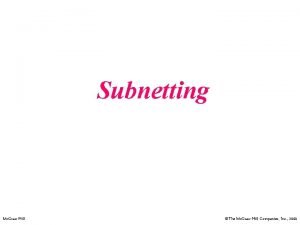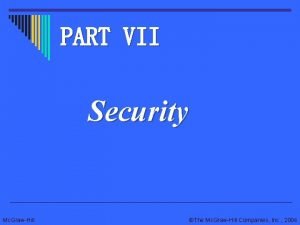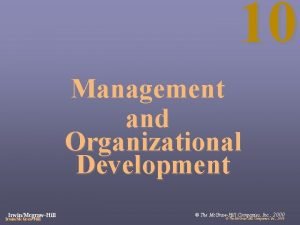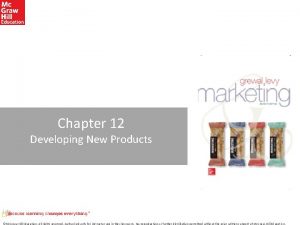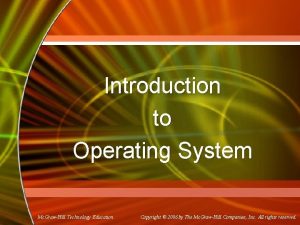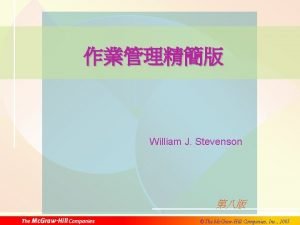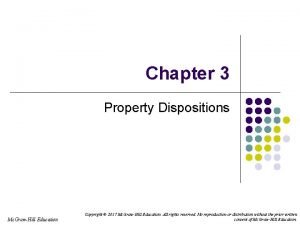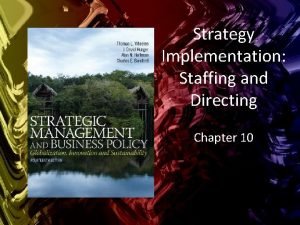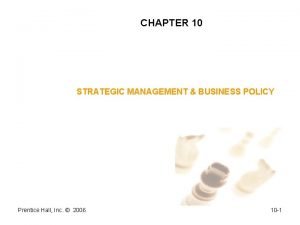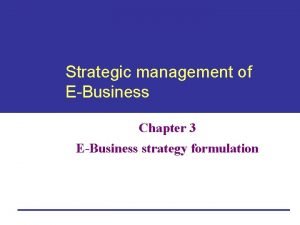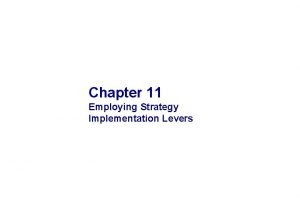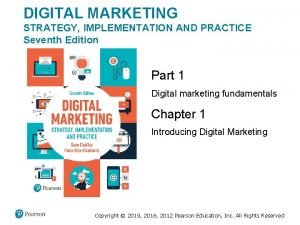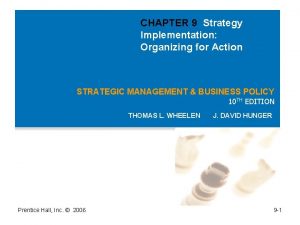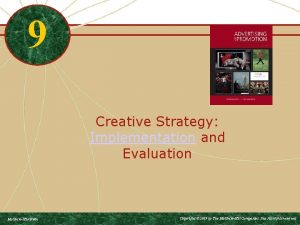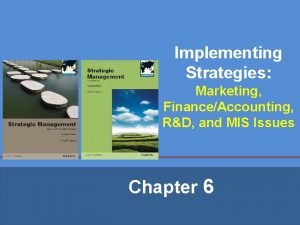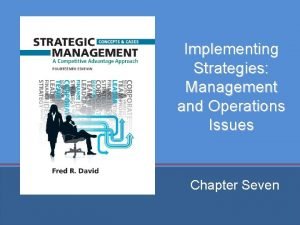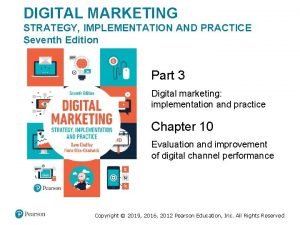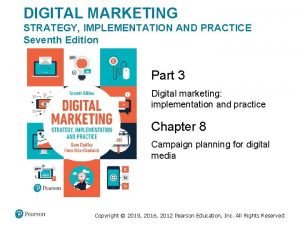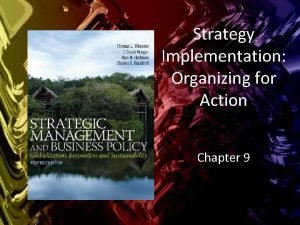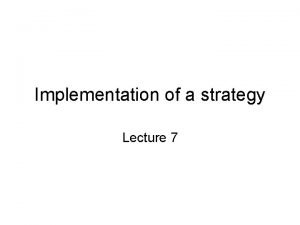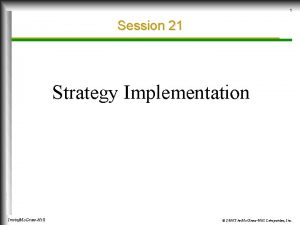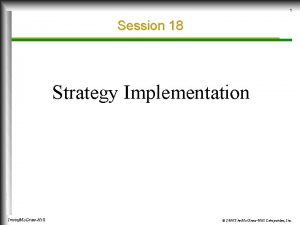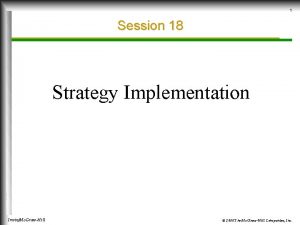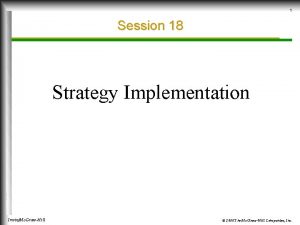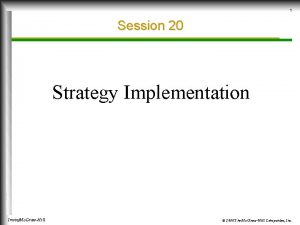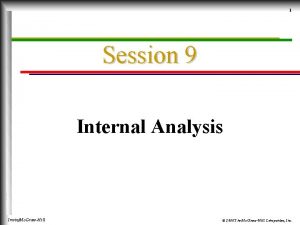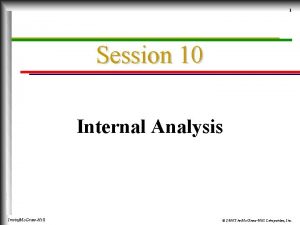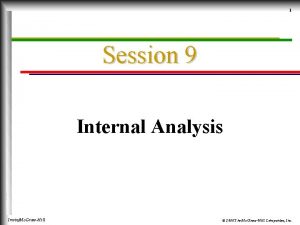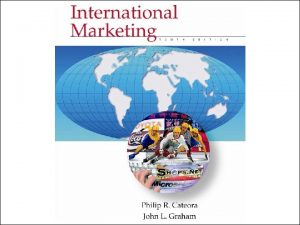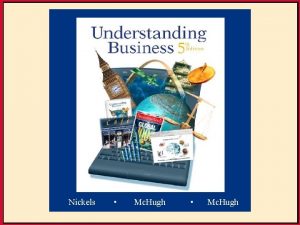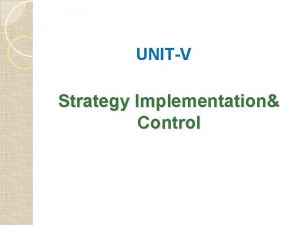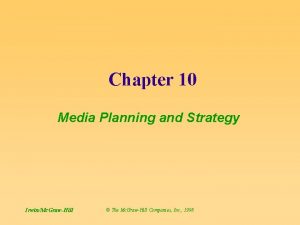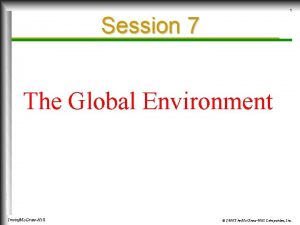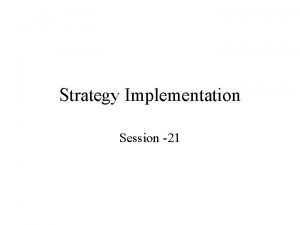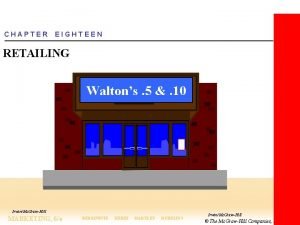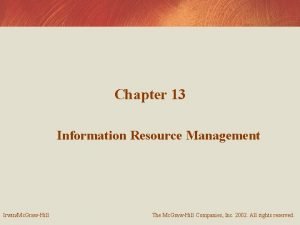1 Session 19 Strategy Implementation IrwinMc GrawHill 2000



























- Slides: 27

1 Session 19 Strategy Implementation Irwin/Mc. Graw-Hill © 2000 The Mc. Graw-Hill Companies, Inc.

Strategic Management Model 2 Company mission & social responsibility External Environment Possible? Internal analysis Desired? Long-term objectives Short-term objectives; reward system Generic & grand strategies Functional tactics Feedback Strategic analysis & choice Policies that empower action Restructuring, reengineering & refocusing the organization Legend Major impact Minor impact Irwin/Mc. Graw-Hill Strategic control & continuous improvement © 2000 The Mc. Graw-Hill Companies, Inc.

3 Strategy Implementation Identify short-term objectives Involves development of support systems that Initiate specific functional tactics Communicate policies to empower people Design effective support systems Irwin/Mc. Graw-Hill © 2000 The Mc. Graw-Hill Companies, Inc.

4 What are Short-Term Objectives? Provide specific guidance for what is to be done, translating vision into action Irwin/Mc. Graw-Hill © 2000 The Mc. Graw-Hill Companies, Inc.

5 Role of Short-Term Objectives in Implementing Strategy 1. “Operationalize” long-term objectives 2. Raise issues and potential conflicts requiring coordination to avoid dysfunctional consequences 3. Identify measurable outcomes of functional activities to be used to make feedback, correction, and evaluation more relevant Irwin/Mc. Graw-Hill © 2000 The Mc. Graw-Hill Companies, Inc.

6 Potential Conflicting Objectives and Priorities Objectives Responsibilities Chief Executive Officer Marketing Finance and accounting • Distribution channels • Customer service • Inventory obsolescence • Communications and data processing • Carrying inventory • More inventory • Less inventory • Frequent short runs • Fast order processing • Cheap order processing Irwin/Mc. Graw-Hill • Production supply alternatives • Warehousing • Transportation • Long production runs • Lowest cost routing • Fast delivery • Field warehousing Manufacturing • Less warehousing • Plant warehousing © 2000 The Mc. Graw-Hill Companies, Inc.

Relationship of Functional Tactics (Action Plans) to Short-Term Objectives 7 Specificity - Identify functional activities to be undertaken to build competitive advantage Action plans enhance shortterm objectives in three ways Provide a clear time frame for completion Identify who is responsible for each action in the plan Irwin/Mc. Graw-Hill © 2000 The Mc. Graw-Hill Companies, Inc.

8 Qualities of Effective Short-term Objectives Measurable Prioritized Irwin/Mc. Graw-Hill Linked to longterm objectives © 2000 The Mc. Graw-Hill Companies, Inc.

9 Creating Measurable Objectives Examples of Deficient Objectives To improve morale in the division (plant, department, etc. ) Examples of Objectives with Measurable Criteria for Performance • To reduce turnover (absenteeism, number of rejects, etc. ) among sales managers by 10 percent by January 1, 2001. Assumption: Morale is related to measurable outcomes (I. e. , high and low morale are associated with different results). • To reduce the time lapse between order data and delivery by 8 percent (two days) by June 1, 2001. To improve reduce the cost of goods produced by 6 percent to support a support of sales • To product price decrease of 2 percent by December 1, 2001. effort • To increase the rate of before- or on-schedule delivery by 5 To improve firm’s image Irwin/Mc. Graw-Hill percent by June 1, 2001. • To conduct a public opinion poll using random samples in the five largest U. S. metropolitan markets to determine average scores on 10 dimensions of corporate responsibility by May 15, 2001. To increase our score on those dimensions by an average of 7. 5 percent by May 1, 2002. © 2000 The Mc. Graw-Hill Companies, Inc.

10 Value-Added Benefits of Short-Term Objectives Give operating personnel a better understanding of their role in a firm’s mission Provide basis for accomplishing conflicting concerns Provide basis for strategic control Motivation - Clarify personal and group roles in a firm’s strategies Irwin/Mc. Graw-Hill © 2000 The Mc. Graw-Hill Companies, Inc.

11 What are Functional Tactics? Key, routine activities that must be undertaken in each functional area to provide the business’s products Translate grand strategies into action designed to accomplish specific short-term objectives Irwin/Mc. Graw-Hill © 2000 The Mc. Graw-Hill Companies, Inc.

12 Functional Tactics at General Cinema Corporation Corporate Strategy Business Strategies Corporate strategy Achieve 15 -20 % annual growth through existing businesses and carefully selected diversification into leisure-oriented, consumer-oriented product/service businesses to absorb increasing cash flow from theater and softdrink bottling operations. Irwin/Mc. Graw-Hill Soft drink bottlers Movie exhibition Sunkist products Concentration and market development selective Maintain and selectively expand leading nationwide position in the movie exhibition industry to provide positive cash flow for corporate diversification. Functional Tactics Functional tactics: Marketing Seek only first-run films by outbidding competition in each local market; provide primarily family-oriented movies; and maintain an admission price only slightly above that of local competition. Functional tactics: Finance Use lease or sale and leaseback arrangements of each theater to maximize cash flow for corporate expansions; seek profitability through volume, not higher ticket prices. Functional tactics: Operations Use multiscreen facilities with minimal maintenance requirements and a joint service area to serve each minitheater. © 2000 The Mc. Graw-Hill Companies, Inc.

13 Differences Between Business Strategies and Functional Tactics Time Horizon • Shorter time horizon of functional tactics contributes to successful implementation by • Focusing attention on what needs to be done now • Allowing functional managers to adjust to changing current conditions Irwin/Mc. Graw-Hill Specificity • Greater specificity of functional tactics contributes to successful implementation by • Ensuring functional managers focus on accomplishments • Clarifying for top managers how functional managers intend to accomplish business strategy • Facilitating coordination among operating units Participants • General managers establish long-term objectives and overall business strategies • Operating managers establish short-term objectives and functional tactics leading to business level success © 2000 The Mc. Graw-Hill Companies, Inc.

14 Characteristics of Functional Tactics in Production/Operations Viewed as core function of an organization l Involves converting inputs into value-enhanced output l Focuses on decisions regarding l l Basic nature of firm’s POM system, l l Seeks optimum balance between investment input and production/operations output Location Facilities design Process planning on a short-term basis Irwin/Mc. Graw-Hill © 2000 The Mc. Graw-Hill Companies, Inc.

15 Key Functional Tactics in POM Functional Tactic Facilities and equipment Typical Questions the Functional Tactic Should Answer • How centralized should the facilities be? • How integrated should the separate processes be? • To what extent should further mechanization or automation be pursued? • Should size and capacity be oriented toward peak or normal operating levels? • How many sources are needed? • How should suppliers be selected, and how should relationships with Sourcing suppliers be managed over time? • What level of forward buying (hedging) is appropriate? • Should work be scheduled to order or to stock? • What level of inventory is appropriate? • How should inventory be used (FIFO/LIFO), controlled, and Operations planning replenished? and control • What are the key foci for control efforts? • Should maintenance be oriented to prevention or to breakdown? Irwin/Mc. Graw-Hill © 2000 The Mc. Graw-Hill Companies, Inc.

16 Characteristics of Functional Tactics in Marketing Lead to strategic success of the firm through the profitable sale of products/services in target markets l Clearly identify customer needs that products/services aim to meet l Identify where, when, and by whom products/services are to be sold l Define how firm will communicate with target markets l Directly influence supply, demand, profitability, consumer perception, and regulatory response through pricing l Irwin/Mc. Graw-Hill © 2000 The Mc. Graw-Hill Companies, Inc.

17 Key Functional Tactics in Marketing Functional Tactic Product or service Price Place Promotion Irwin/Mc. Graw-Hill Typical Questions the Functional Tactic Should Answer • • • • • Which products do we emphasize? Which products/services contribute most to profitability? What product/service image do we seek to project? What consumer needs does the product/service seek to meet? What changes should be influencing our customer orientation? Are we competing primarily on price? Can we offer discounts or other pricing modifications? Are our pricing policies standard nationally, or is there regional control? What price segments are targeting? What is the gross profit margin? What level of market coverage is necessary? Are there priority geographic areas? What are the key channels of distribution? What are the channel objectives, structure, and management? What sales organization do we want? What are the key promotion priorities and approaches? Which advertising/communication priorities and approaches are linked to different products, markets, and territories? • Which media would be most consistent with the total marketing strategy? © 2000 The Mc. Graw-Hill Companies, Inc.

Characteristics of Functional Tactics in Accounting and Finance l l Time frame of finance tactics varies because they direct use of financial resources supporting the business strategy, long-term goals, and annual objectives Long-term tactics guide decisions in l l l Long-term capital investment Debt financing Dividend allocation Leveraging Short-term tactics guide decisions in l l 18 Managing working capital and short-term assets Accounting-focused tactics have taken on increased strategic significance in last decade Irwin/Mc. Graw-Hill © 2000 The Mc. Graw-Hill Companies, Inc.

19 Key Functional Tactics in Finance and Accounting Functional Tactic Capital acquisition Capital allocation Dividend and working capital management Irwin/Mc. Graw-Hill Typical Questions the Functional Tactic Should Answer • What is an acceptable cost of capital? • What is desired proportion of short- and long-term debt? Preferred • • • and common stock? What balance is desired between internal and external funding? What risk and ownership restrictions are appropriate? What level and forms of leasing should be used? What are the priorities for capital allocation projects? On what basis should the final selection of projects be made? What level of capital allocation can be made by operating managers without higher approval? • • • What portion of earnings should be paid out as dividends? Are things other than cash appropriate as dividends? What are the cash flow requirements? Minimum and maximum? How liberal/conservative should credit policies be? What limits, payment terms, and collection procedures are necessary? What payment timing and procedure should be followed? © 2000 The Mc. Graw-Hill Companies, Inc.

20 Characteristics of Functional Tactics in R&D Irwin/Mc. Graw-Hill l Assumed a key strategic role in many firms due to increasing rate of technological change l May be more critical instruments of business strategy in some industries than in others © 2000 The Mc. Graw-Hill Companies, Inc.

21 Key Functional Tactics in R&D Functional Tactic Basic research vs. product and process development Time horizon Organizational fit Typical Questions the Functional Tactic Should Answer • To what extent should innovation and breakthrough research be • • emphasized? In relation to the emphasis on product development, refinement, and modification? What critical operating processes need R&D attention? What new products are necessary to support growth? Is the emphasis short-term or long-term? Which orientation best supports the business strategy? The marketing and production strategy? • Should R&D be done in-house or contracted out? • Should R&D be centralized or decentralized? • What should be the relationship between the R&D units and product managers? Marketing managers? Production managers? • Should the firm maintain an offensive posture, seeking to lead innovation Basic R&D posture Irwin/Mc. Graw-Hill in its industry? • Should the firm adopt a defensive posture, responding to the innovations of its competitors? © 2000 The Mc. Graw-Hill Companies, Inc.

22 Characteristics of Functional Tactics in HRM Assumed increasing strategic importance in the 1990 s l Aid long-term success in l l Development of managerial talent and competent employees Creating systems to manage compensation or regulatory concerns Guiding effective utilization of human resources to achieve both the l l Irwin/Mc. Graw-Hill Firm’s short-term objectives Employees’ satisfaction and development © 2000 The Mc. Graw-Hill Companies, Inc.

23 Key Functional Tactics in HRM Functional Tactic Typical Questions the Functional Tactic Should Answer Career development and training • • Compensation • What levels of pay are appropriate for the tasks we require? • How can we motivate and retain good people? • How should we interpret our payment, incentive, benefit, and seniority Recruitment, selection, and orientation What key human resources are needed to support chosen strategy? How do we recruit these human resources? How sophisticated should our selection process be? How should we introduce new employees to the organization? What are our future human resource needs? How can we prepare our people to meet these needs? How can we help our people develop? Evaluation, discipline, and control policies? • How often should we evaluate our people? Formally or informally? • What disciplinary steps should we take to deal with poor performance or inappropriate behavior? • In what ways should we “control” individual and group performance? Labor relations and EEO requirements • How can we maximize labor-management cooperation? • How do our personnel practices affect women/minorities/ • Should we have hiring policies? Irwin/Mc. Graw-Hill © 2000 The Mc. Graw-Hill Companies, Inc.

24 Role of Policies in Implementing Strategy l Directives designed to guide thinking, decisions, and actions of managers and employees in implementing strategy l Increase managerial effectiveness by l l Standardizing many routine decisions l Clarifying discretion managers and employees can exercise in implementing functional tactics Should be derived from functional tactics with key purpose of aiding strategy execution Irwin/Mc. Graw-Hill © 2000 The Mc. Graw-Hill Companies, Inc.

25 Why Policies Empower People 1. Establish indirect control over independent action by clearly stating how things are to be done now 2. Promote uniform handling of similar activities 3. Ensure quicker decisions by standardizing answers to previously answered questions 4. Institutionalize basic aspects of organization behavior 5. Reduce uncertainty in repetitive and day-to-day decision making 6. Counteract resistance to or rejection of chosen strategies by organization members 7. Offer predetermined answers to routine problems 8. Afford managers a mechanism for avoiding hasty and ill-conceived decisions in changing operations Irwin/Mc. Graw-Hill © 2000 The Mc. Graw-Hill Companies, Inc.

26 Advantages of Formal Written Policies 1. Require managers to think through policy’s meaning, content, and intended use 2. Reduce misunderstanding 3. Make equitable and consistent treatment of problems more likely 4. Ensure unalterable transmission of policies 5. Communicate authorization or sanction of policies more clearly 6. Supply a convenient and authoritative reference 7. Systematically enhance indirect control and organizationwide coordination of the key purposes of policies Irwin/Mc. Graw-Hill © 2000 The Mc. Graw-Hill Companies, Inc.

27 Types of Executive Bonus Compensation Bonus Type Description Rationale Shortcomings Stock option grants Right to purchase stock in the future at a price set now; compensation determined by “spread” Provides incentive for executive to create wealth for shareholders as measured by increase in firm’s share price Movement in share price does not explain all dimensions of managerial performance Restricted stock plan Shares given to executive who is prohibited from selling them for a specific time period Golden handcuffs Golden parachute Cash based on internal performance using finance measures Irwin/Mc. Graw-Hill No downside risk to Promotes longer executive, who always tenure than other forms profits unlike other of compensation shareholders May promote risk-averse Bonus income deferred in Offers an incentive for decision making due to a series of annual executive to remain with installments; forfeited downside risk borne by with executive resignation the firm executive Executive has right to Compensation is achieved Offers an incentive for collect bonus if loses whether or not wealth is position due to takeover, executive to remain with created; rewards either firing, retirement, or firm success or failure resignation Bonus compensation Weak correlation between Offsets limitations of based on accounting focusing on market-based earnings measures and performance measures of performance shareholder wealth creation such as return on equity © 2000 The Mc. Graw-Hill Companies, Inc.
 Strategy formulation and implementation
Strategy formulation and implementation Grawhill
Grawhill Mc grawhill
Mc grawhill Grawhill
Grawhill Mc grawhill
Mc grawhill Grawhill
Grawhill Grawhill
Grawhill Single user multitasking os
Single user multitasking os Grawhill
Grawhill Grawhill
Grawhill Staffing issues in strategy implementation
Staffing issues in strategy implementation Strategy implementation
Strategy implementation E learning implementation strategy
E learning implementation strategy Staffing follows strategy adalah
Staffing follows strategy adalah Ebusiness strategy
Ebusiness strategy Lever for strategy implementation
Lever for strategy implementation Digital marketing strategy implementation and practice
Digital marketing strategy implementation and practice Strategy implementation organizing for action
Strategy implementation organizing for action Transformational ads
Transformational ads Mis issues in strategy implementation
Mis issues in strategy implementation Management issues central to strategy implementation
Management issues central to strategy implementation Implementation strategy example
Implementation strategy example Chapter 7 strategic management
Chapter 7 strategic management Digital marketing 7th edition
Digital marketing 7th edition Digital marketing strategy implementation and practice
Digital marketing strategy implementation and practice Structure follows strategy
Structure follows strategy Nature of strategy implementation
Nature of strategy implementation Mis issues in strategy implementation
Mis issues in strategy implementation

